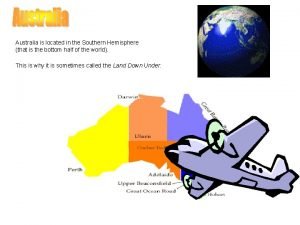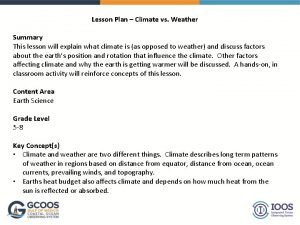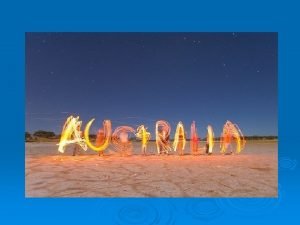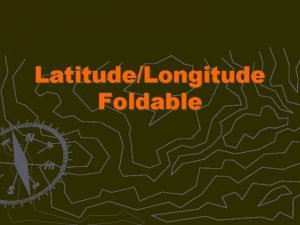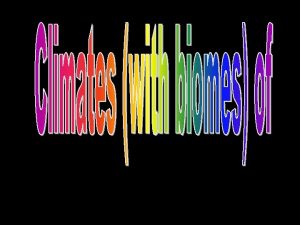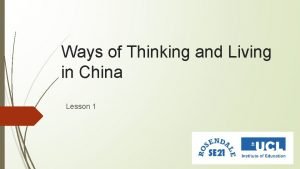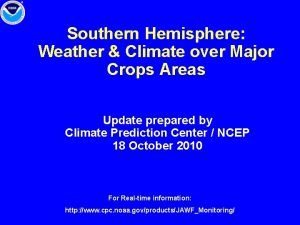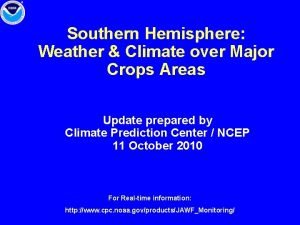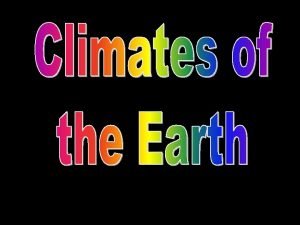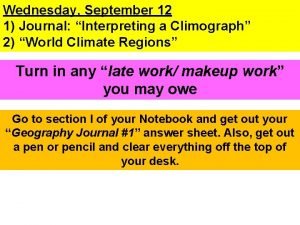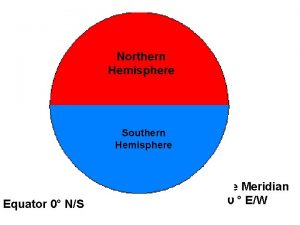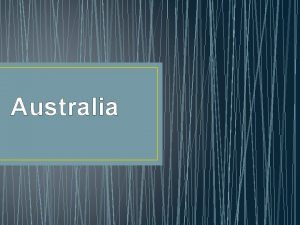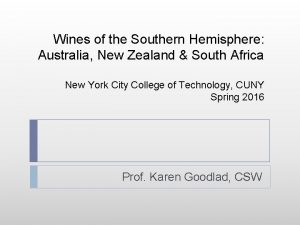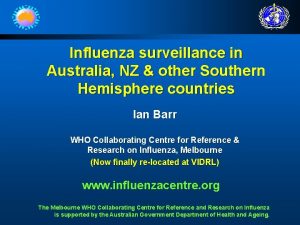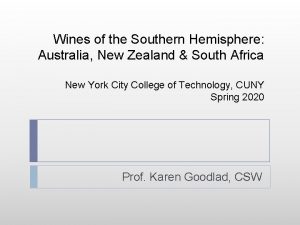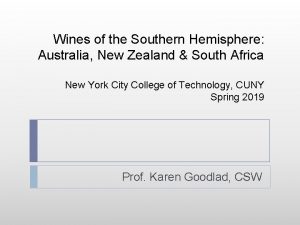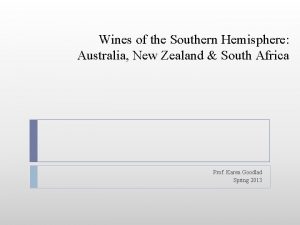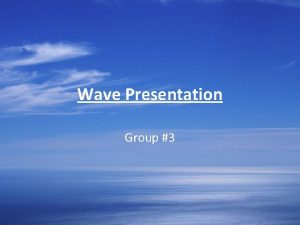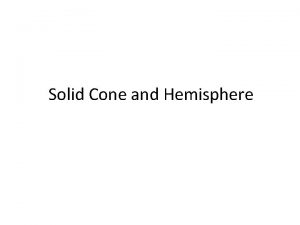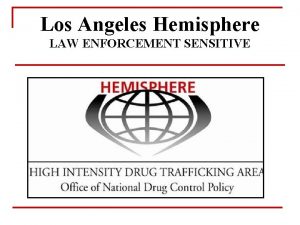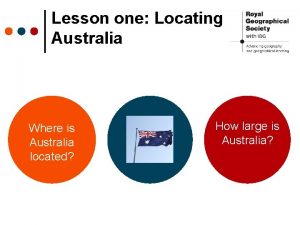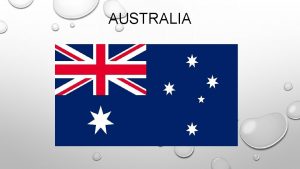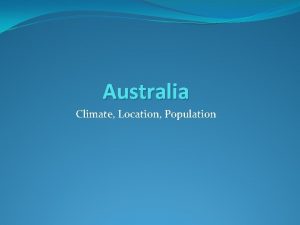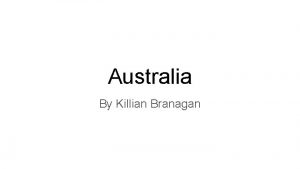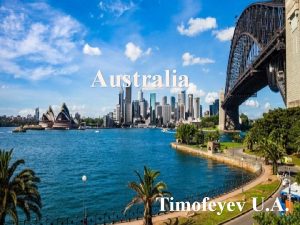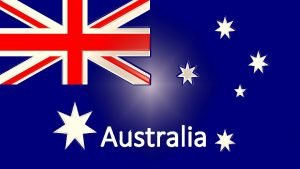Australia is located in the Southern Hemisphere that



















- Slides: 19

Australia is located in the Southern Hemisphere (that is the bottom half of the world). This is why it is sometimes called the Land Down Under.

Australia is the smallest, flattest, and driest inhabited continent in the world. It is the only country which is also a whole continent. 18. 6 million people live here. The people of Australia are called Australians call different parts of their country by different names: The City Is any large city and its suburbs. Over 85% of the people live in cities. Melbourne, Sydney, Brisbane, Perth and Canberra are major cities. The Country Is the area immediately outside the city and usually includes the surrounding smaller towns and farms. Most of what is called "the country" is a stretch of land about 200 kilometres deep around the eastern and southern seaboards of Australia. Upper Beaconsfield, the Great Ocean Road , the Dandenongs, etc are in "the country". The Outback Is the sparsely populated arid interior of Australia. The Australian Outback is both harsh and breathtakingly beautiful. It's like no other place on earth. Coober Pedy, Uluru, etc are in the Outback.

There are 6 states and 2 territories in Australia: Queensland New South Wales South Australia Tasmania Victoria Western Australia Northern Territory Australian Capital Territory The capital of Australia is Canberra. Australia has lots of unusual Animals. Australia has the largest coral reef in the world called the Great Barrier Reef. It is stunning!. Australians speak English. But we also have our own special words and phrases referred to as Strine. Australia's favourite song is Waltzing Matilda.

The Outback is the arid sparsely populated interior of Australia. It makes up almost 85% of Australian landmass. Very few humans live out there. It is also sometimes called "Beyond the Black Stump". The Australian Outback is both harsh and breathtakingly beautiful. It's like nothing else anywhere else in the world. A ROAD TO NEVER-NEVER In the outback you can travel for days without meeting anyone. This is why it is sometimes called the Never-Never: the never ending landscape; the never ending horizon. The land is unforgiving to the careless and foolhardy. You can die of dehydration within hours if you are not careful. DID YOU KNOW? Australia has a railroad track that runs for 478 kilometers in a absolutely straight line. Its called the "long straight". Its is part of the Indian-Pacific railroad that runs from Perth to Sydney. The Indian-Pacific railway is also the longest railway line in the world. It runs for over 4500 kilometres from the Indian Ocean in the west to the Pacific Ocean in the east.

A STATION Yes people actually do live in the outback. Cattle and sheep are grazed on huge tracts of land called Stations (what might be called a ranch in the USA). There are Stations in the outback that occupy more land than some countries. Helicopters and small planes are usually used to round up stock (the sheep and cattle) and to check fences (dingo and rabbit fences). A person who rounds up stock is called a Stockman. A person who works at a Station is called a Stationhand. The owner is called a Station-Manager. ULURU Uluru: Is a huge rock (called a monolith) that sticks out in the middle of the flat desert. From a distance it looks like an impregnable fortress built eons ago by some mythical warlord. Uluru is over nine kilometres (6 miles) around and over 348 metres (1000 ft) high. It is believed to be about 600 million years old and was once part of a huge mountain range. The mountain range has long since disappeared - eroded away by rain and wind. With each passing hour as the sun moves across the sky the rock changes colour - changing from delicate mauve, blues, pinks, browns to fiery red. It is a sacred place to the Pitjanjara Aboriginal tribe.

DEVILS MARBLES Devils Marbles: These massive boulders are scattered along the Stuart Highway near Alice Springs. They glow red in the sunset. Aborigines believe they were left by the Rainbow Serpent of the Dreamtime. WAVE ROCK Wave Rock: Is a huge granite rock that looks like a huge wave that has been frozen in time and turned into stone. It has been made this way by the wind and rain water running down its sides. KIMBERLEY WATERFALLS

KATHERINE GORGE Katherine Gorge: Is one of 13 gorges in Nitmiluk National Park. They began forming about 23 million years ago as torrents of water flowing through tiny cracks in the earth slowly eroded away the earth and rock creating these huge gorges. It is rich in Aboriginal art, with rock paintings representing the spiritual 'dreaming' of the Jawoyn people, the traditional owners of the land. Apart from boat rides through the Gorge, with its sheer towering walls, there also over 100 kilometres of walking tracks and numerous aboriginal rock paintings to visit. THE OLGAS The Olgas: Are enormous domes of red rock located about 32 kms from Uluru. You can walk into valleys and gorges between the 36 rock domes and feel the eerie mystery around you. The Aborigines call it 'Kata Tjuta'. It has great spiritual significance to them.

The name Coober Pedy is derived from the Aboriginal words "kupa piti", which means "white man's burrow". The description is apt because most people live and work underground. Coober Pedy is located 836 kilometres (510 miles) north of Adelaide and about 300 kilometres south of Uluru. It is a desolate landscape devoid of vegetation and water. It is an extremely hot place too. The entire landscape is pockmarked by the telltale tailing of countless opal mines. In 1915 a young boy named Willie Hutchison, who was out with his father prospecting for gold, discovered the first opal there. Since then the town has grown to about 2500 people. Coober Pedy produces about 90% of the world's opals. Because of the extreme heat during the summer almost all buildings are located underground.

The Great Barrier Reef stretches along the east coast of Queensland in Australia. It is the world's largest coral reef. It is over 2000 km (1250 miles) long! It is not a single reef at all. It is made up of over 2900 individual reefs very close to each other. WHAT IS A CORAL REEF? A coral is a tiny marine polyp. It is the living part of the coral reef. There are many different kinds of corals. These are what gives the coral reef its colourful appearance. Corals feed mostly on plankton. Coral grows in warm climates where there is clear salt water and sunlight. They don't like pollution. A coral reef is a natural barrier made of the bodies of living and dead coral. It is normally just below the surface of the water. It is made of two parts the: • white part is made from the bodies of zillions and zillions of polyps which have died over hundreds and thousands of years. • colourful part is the living part of the coral reef. It is made up of living polyps.

WHO LIVES HERE? • 1500 species of fish • 400 different types of coral • 4, 00 molluscs (like clams and the sea slug) • 500 species of seaweed • 215 species of birds • 16 species of sea snake • 6 species of sea turtle Grouper Seal Jelly fish Green Turtle Manta Ray

Sydney is the capital of the state of New South Wales in Australia. It is the largest city in Australia. THE CITY Sydney is Australia's oldest and largest city. About 3. 8 million people live in the greater Sydney area. The defining symbols of Sydney are its Opera House and "coat hanger bridge". Sydney is the commercial capital of Australia. The people of Sydney came from all over the world. OPERA HOUSE The Opera House, situated at Bennelong Point, is an absolutely exquisite building. Its roofline is meant to symbolise the bellowing "sails" of sailing ships of a bygone era and the spinnakers of the racing yachts that ply the harbour today. DID YOU KNOW The Sydney Opera House: • Took 14 years to build and cost $102, 0000 when completed in 1973. • Was designed by the Danish architect Jorn Utzon. • Covers 1. 8 hectares (4. 5 acres). • Is 185 metres (611 feet) long, 120 metres (380 feet) wide and the tip of its highest arch is 67 metres (221 feet) above sea level. • Roofs are made up of 2, 194 pre-cast concert sections held together by 350 kilometres (217 miles) of steel cable. • Roofs are covered with over 1, 056, 000 tiles. • Hosts over 3000 events each year with audiences of around 2 million people. • Has nearly 200, 000 visitors on guided tours each year.

THE HARBOUR BRIDGE The Sydney Harbour Bridge took seven years to build and was opened in 1932. DID YOU KNOW • The steel used for the bridge weights over 52, 800 tonnes. • There are over 6 million steel rivets in the bridge. • It took till 1988 to finally pay off the cost of building the bridge. • It takes 30, 00 0 lifers of paint to paint the bridge. THE BEACH Almost 80% of the Australian population live within a few hours drive from the beach. Sydney more than any other city is renowned for its beaches (Bondi being the most famous) and of course its lifeguards. HISTORY OF SYDNEY The Aboriginal people lived around the area that is now Sydney for thousands of years before the first european settlers arrived in the 1770's. The area that is now Sydney was named Port Jackson by captain James Cook when he visited the east coast of Australia in 1770. Port Jackson was selected by Captain Arthur Phillip as the most suitable site for the first european settlement in Australia in 1788. He named the place after the British Prime Minister at the time: Lord Sydney. The colony faced many hardships and near starvation trying to grow crops in this new land. After the initial difficulties however the colony grew rapidly as new migrates arrived in larger numbers.

The capital of Australia is Canberra. It is where the federal government resides. THE CITY Canberra is a city of about 310, 000 people located in the Australian Capital Territory (ACT) approximately 200 kilometres from Sydney. Most of the people in Canberra are employed by the federal government. Canberra is a very young city. The plans for the city were only drawn up in 1911 and construction didn't commence until 1913. The grand design for the city was drawn up by a relatively obscure american architect named Walter Burley Griffin. The lake which is a central focus of the city today is named after him. With its imposing buildings, broad boulevards and uncluttered streetscape (there are no billboards, in Canberra) it lacks the charm and vibrancy of more cosmopolitan cities such as Sydney and Melbourne. FEDERAL PARLIAMENT HOUSE The Federal Parliament House is built on top of Capital Hill. It was completed in 1988 and replaces the old parliament house which is located further down the hill. The building was designed to merge into the profile of the hill itself. A stainless steel flag mast 81 metres tall surmounts the building from which flutters the Australian flag (the flag is as big as a double decker bus). It cost over 800 million dollars to build and is considered to be one of the most attractive parliament buildings anywhere in the world.

Melbourne is the capital of the state of Victoria in Australia. It is the second largest city in Australia. It was voted the worlds' most livable city in 1994. And the least polluted for a city of its size. THE CITY Melbourne is renowned for its parks, fickle weather, clanging trams, upsidedown river, football and its cosmopolitan outlook. It is also the financial capital of Australia. It is a relatively safe city with a very low crime rate. About 3. 2 million people live in the greater Melbourne area. The people of Melbourne came from all over the world. YARRA RIVER The Yarra River flows right by the city. It is sometimes called "the river that flows upside down" because of its muddy colour. The reason for this colour is because mud particles stay suspended in the water and don't settle to the bottom like in most rivers. It is a very clean river (now). During the warmer months people like to walk along the river, visit the parks and sunbathe (ouch) along the banks. The Moomba festival also has a lot of events on the river. I love the birdman competition where they try to see who can fly the furthest after jumping off a bridge. Its very funny.

TRAMS Melbourne loves its electric trams. It is the only city in Australia which still has them as part of its public transport system. We paint some of them with interesting designs and motifs. There is even a tram restaurant where you can dine while trundling past interesting city sites. Trams have right of way on our roads and also make us do unusual right hand turns at city intersections. ARTS CENTRE The Arts Centre is a short walk across Princes Bridge on St Kilda Road and is now a part of the larger Southgate entertainment complex. It consists of the: National Gallery of Victoria with its large collection of works by local and overseas artists. Melbourne Concert Hall which can seat 2600 people and has fantastic acoustics. State Theaters home of the Australian Ballet and Opera Companies. The Art Centre's lattice work spire glows a light purple colour at night and can be seen from miles around. The water wall at the museum is very popular with young kids. BOTANICAL GARDENS Melbourne has many public parks and gardens within walking distance of the city centre: • Botanical Gardens was created in the English landscape tradition and extends for 36 hectares along the Yarra River. • Flagstaff Gardens the city's first public gardens. • Fitzroy Gardens has Captain Cooks Cottage, the Fairy Tree carved with tiny figures and a model Tudor village. • Treasury Gardens is close to the state government offices. • Carlton Gardens where the Exhibition Buildings are situated. • Kings Domain contains the Shrine of Remembrance, La Trobe's Cottage and the Myer Music Bowl.

The Great Ocean Road starts at Torquay (about 100 kms from Melbourne) and winds its way for 180 kms along the southwestern coast of Victoria , Australia. It is one of the most spectacular coastal drives in the world. It winds its ways around ragged cliffs, windswept beaches, and tall buffs and passes through lush mountain rainforest and towering eucalyptus. The Great Ocean Road was started in 1918 and completed during the Great Depression as a public works project to give returned soldiers and unemployed people work. Some of the sights along the way are: • Bells Beach - a great place to go surfing and where the Bells Surfing Classic is held each Easter. • Shipwreck Coast - where the wrecks of over 80 ships lie on the ocean floor. Many ships carrying immigrants to the gold fields of Victoria floundered in the treacherous seas. • Lorne - a popular sea side resort in Apollo Bay. • Port Campbell National Park - One of the most photographed sections of the road where shear golden limestone cliffs and rock formations withstand the buffeting of fierce seas. • Twelve Apostles (there are only 10 left!) • London Bridge (This is what it looked like before one of its spans collapsed) • Loch Ard Gorge - where in 1878 the clipper Loch Ard was driven into rocks during a storm with the loss of 52 lives. • Otway National Park • Port Fairy - a well preserved fishing village which was settled by Twelve Apostles sealers and whalers back in the 1820 s.

Upper Beaconsfield is located 53 kms (33 miles) south-east of Melbourne in the Dandenong Ranges on the southern foothills of the Great Dividing Range. Upper Beaconsfield retains much of its rural heritage and atmosphere with tree lined streets, varied eucalyptus forests, wet-lands, fern gullies and secluded creeks. The large residential blocks blend well with the surrounding environment. There are strict laws protecting the local flora and fauna. STONEY CREEK We go to Stony Creek on hikes, to catch yabbies and fish. It's lots of fun. It isn't usually misty like in this picture. There are lots of native ferns and gum trees around the creek. There are Platypuses in the creek but they are very shy and hide when us kids come by. Here are some of the native animals found around Upper Beaconsfield: Bushtail Antechinus Feathertail Glider Bandicoot Leadbeater's Bat ELEPHANT ROCK Elephant Rock is located on the Pygmy Cockatoo Beaconsfield-Emerald Road . Kids Ringtail Echidna paint it in all sorts of colours. There is Sugar Glider Kangaroo a good lookout from where you can Kookaburra Red-Bellied Black Snake see Cardinia Dam. There also Tawny Frogmouth Platypus good walking tracks there. Wallaby Possums: Wombat There used to be Koalas too but not any more.

Victoria is the smallest state on the Australian mainland. It is 227, 600 sq km in size. About 4. 5 million people live in Victoria. Melbourne is the capital of the state of Victoria in Australia. It is the second largest city in Australia. Over 70% of the population of Victoria live in Melbourne has many parks and gardens and is a very green city. About 3. 2 million people live in Melbourne. THE GREAT OCEAN ROAD The Great Ocean Road winds its way along the south-western coast of Victoria for 180 kms. It is one of the most spectacular coastal drives in the world winding its ways around ragged cliffs, windswept beaches, and tall buffs and passes through lush rainforest and eucalyptus. THE DANDENONGS The Dandenong Ranges are located about 40 kilometres from Melbourne and form the southern potion of the Great Dividing Range. There are many lush fern gullies and eucalypt forests within the Dandenongs. The Puffing Billy steam railway runs through the Dandenong Ranges from Belgrave to Emerald. It's great fun. Sometimes we can hear its whistle from our garden as far away as Upper Beaconsfield. The Healesville Sanctuary with its many native animals is very interesting place for a day out.

 What hemisphere is australia located in
What hemisphere is australia located in Spring summer winter fall
Spring summer winter fall Australia is a country in the southern
Australia is a country in the southern Western and eastern hemisphere
Western and eastern hemisphere Northern hemisphere climograph
Northern hemisphere climograph China hemisphere
China hemisphere Southern hemisphere weather patterns
Southern hemisphere weather patterns Which hemisphere is japan located?
Which hemisphere is japan located? Southern hemisphere weather forecast
Southern hemisphere weather forecast Climograph of moscow
Climograph of moscow Climograph of bangkok
Climograph of bangkok Sau thất bại ở hồ điển triệt
Sau thất bại ở hồ điển triệt Block xoang nhĩ
Block xoang nhĩ Con hãy đưa tay khi thấy người vấp ngã
Con hãy đưa tay khi thấy người vấp ngã Thơ thất ngôn tứ tuyệt đường luật
Thơ thất ngôn tứ tuyệt đường luật Tôn thất thuyết là ai
Tôn thất thuyết là ai Chiến lược kinh doanh quốc tế của walmart
Chiến lược kinh doanh quốc tế của walmart Thơ thất ngôn tứ tuyệt đường luật
Thơ thất ngôn tứ tuyệt đường luật Gây tê cơ vuông thắt lưng
Gây tê cơ vuông thắt lưng Phân độ lown
Phân độ lown
